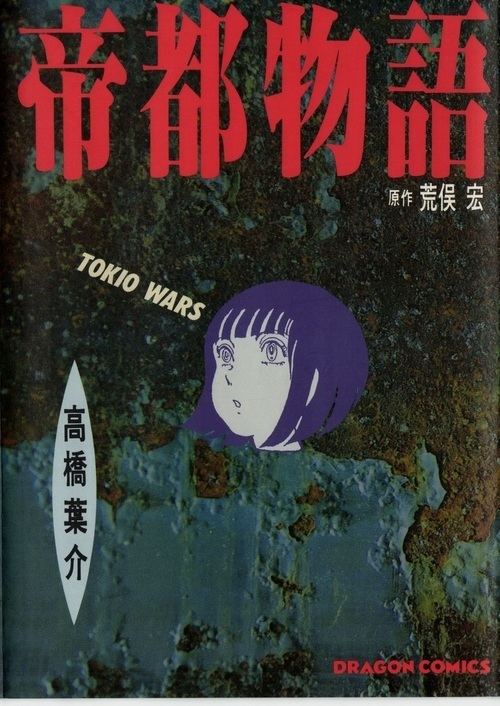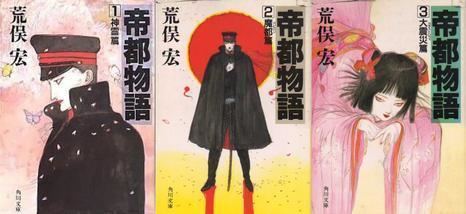Published 1985–1989 | ||
 | ||
Genres Alternate history, Dark fantasy, Historical fantasy, Horror fiction, Science Fiction, Urban fantasy Fantasy books Utsunomiko, Essential Man‑Thing - Vol 1, Sector General, Three Days to Never, The runaway parents | ||
Teito monogatari tokyo doomed megapolis english subtitles
Teito Monogatari (帝都物語, lit., The Tale of the Imperial Capital) is an epic historical dark fantasy/science fiction work; the debut novel of natural history researcher and polymath Hiroshi Aramata. It began circulation in a literary magazine owned by Kadokawa Shoten in 1983, and was published in 10 volumes over the course of 1985–1987. The novel is a romanticized retelling of the 20th-century history of Tokyo from an occultist perspective.
Contents
- Teito monogatari tokyo doomed megapolis english subtitles
- Overview
- List of characters
- Volumes
- List of publications
- Concept and creation
- Legacy
- Analysis
- Spin offs and Prequels
- Stage
- Manga
- Film
- Video games
- References
Widely regarded as the first novel to popularize onmyōdō and fūsui mythology in modern Japanese fiction, the work was a major success in its native country. It won the 1987 Nihon SF Taisho Award, sold over 5 million copies in Japan alone, inspired several adaptations as well as a long running literary franchise and started a new wave of occult fiction. Likewise its influence can still be felt to this day.
Overview

The work is a re-imagining of the 20th century of Tokyo as influenced by the occult. Most of the subject matter builds upon references to classic Japanese and Chinese folklore, although the centerpiece of the mythology is the legend of Taira no Masakado, a 10th-century warlord and ferocious onryo who was placated into a guardian kami through centuries of worship.
The plot features many characters, both historical and fictional. Most of the narrative revolves around the cryptohistorical actions of Yasunori Katō, a mysterious former lieutenant of the Imperial Japanese Army who is himself a vengeful oni; a descendant of the people who rebelled against the Japanese Empire in ancient times. With an incredible knowledge of the supernatural and allies in China, Korea and Taiwan; Katō dedicates his life to crippling Tokyo, the seat of power of the modern Japanese Empire. His ruinous ambitions bring him into conflict with some of 20th century Japan's greatest minds including industrialist Eiichi Shibusawa, onmyoji Abe no Seimei's descendant Yasumasa Hirai, authors Koda Rohan and Izumi Kyoka; physicist Torahiko Terada, and author Yukio Mishima. The resulting conflict, involving science, magic and politics; spans 90 years of Japan's history.
The story begins near the end of the Meiji period and ranges through the rest of the century. It reinvents major events such as the Great Kantō earthquake, the founding of Japan's first subway, the February 26 Incident, the firebombing raids, the signing of the 1960 US Security Pact, the ritual suicide of Yukio Mishima. The narrative finally reaches its climax in 1998, the 73rd year of a fictional Shōwa period.
List of characters
The historical characters who play primary or supporting roles in the story include:
Volumes
The tenth volume of the novel, published in 1987, was originally intended to be the final volume. However, when the novel was republished in 1987-1989, additional eleventh and twelfth volumes were also written to supplement more of the story around 1945, the end of World War II. When the novel was republished in 1995, volumes 11 and 12 were inserted in the chronologically appropriate spot between volumes 5 and 6.
List of publications
Concept and creation
The novel originally served as a minor side project for Hiroshi Aramata who, at the time, was focused on gathering materials for an upcoming natural history book he planned to publish. He was asked by the editor in chief of Kadokawa Shoten, Hiroshi Morinaga, to produce a fantasy themed work for their periodical Monthly King Novel. At that time, Aramata had never written a fictional novel before. The initial idea for the story came from the legend of Taira no Masakado. Aramata was fascinated by the legacy of his spirit and its superstitious impact on modern Japan.
In addition, while participating in the creation of Heibonsha World Encyclopedia, Hiroshi Aramata was inspired by discussions with anthropologist Komatsu Kazuhiko about sources of the strange and the mysterious in Japanese folklore. Around the same time, Aramata also read Murayama Shinichi's non fiction history of onmyodo Nihon Onmyodoshi Sosetsu.
Legacy
Teito Monogatari is widely credited as the beginning of the "onmyōdō/occult" boom, which grew to extreme prominence in Japanese popular culture during the late 80s and 90s. The work was influential in establishing new motifs in occult Japanese fiction such as shikigami, kodoku magic, shijie, gohō dōji and Kimon Tonkou magic; many of which are taken for granted today. It also sparked a surge of mainstream interest in feng shui across Japan. Baku Yumemakura, widely regarded author of the bestselling Onmyoji novel and manga series, has often cited Teito Monogatari as a significant inspiration and credits it with the beginning of the Abe no Seimei boom in popular media. Other similarly themed franchises which emerged in the wake of the novel's success include Clamp's Tokyo Babylon manga series, and Natsuhiko Kyogoku's Kyōgokudō (京極堂) series.
Professor of Human Geography Paul Waley cites Teito Monogatari as a catalyst for reminding a generation of Japanese readers about Tokyo's former status as an Imperial Capital. Dr. Noriko T. Reider, associate professor of Japanese Studies at Miami University, describes Teito Monogatari as an "exemplary work of fiction" and credits it with raising "the oni's status and popularity greatly in modern times". In 2009 Higashi Masao, a notable authority in the field of Japanese weird fiction, wrote an article entitled "The Impact of Teito Monogatari" where he discussed the novel's influence on contemporary Japanese supernatural fiction. Akira Okawada, a specialist in Japanese science fiction literature, wrote a similar article in 2010 discussing the work's influence on that respective genre.
Analysis
In her essay "Oni and Japanese Identity", Dr. Noriko T. Reider argues that the work is a heterotopic inversion of classical oni mythology heavily influenced by the supernatural configuration brought about by World War II. She describes the novel as a "...heterotopic site where...contemporary representations of oni reflect past representations, where oni of the past are not simply superimposed upon the present but both act as extensions of each other in an odd continuum". The character of Yasunori Kato is intended as a homage to classic heroes from Japanese folklore such as Minamoto no Raiko (an imperial soldier related to oni) and Abe no Seimei. Whereas those heroes were ardent defenders and valuable servants of the Empire though, Kato is presented as its worst possible enemy. This inversion is also reflected in the character of Taira no Masakado, whom at the beginning is demonized by the narrator and the Japanese government as a national rebel and a threat. However, the story unfolds with him in the role of Tokyo's benevolent guardian deity worshiped by the various protectors of the city. The negative association becomes a positive one. Another example is found in the novel's fictional version of Emperor Hirohito. In pre-war Japanese culture, the Emperor was regarded as a divine figure incapable of human failing. In Teito Monogatari however, the Showa Emperor is presented as a frail figure who prolongs his life by unwittingly ingesting a nostrum made from human organs. This practice of cannibalism effectively puts him on the level of oni, a major paradox since the Emperor's divine status and the status of oni are incompatible with each other. If even the Emperor of Japan has the potential to become an oni, then when is an oni not an oni?
Spin-offs and Prequels
Stage
A humorous stage adaptation of the novel was performed by the Tokyo Grand Guignol Theater in the mid-1980s. It is most notable for introducing the talents of its star Kyūsaku Shimada, the actor who would become most associated with the image of the protagonist Yasunori Kato in future film adaptations.
Manga
Film
In 1987, a cinematic adaptation of the same name, adapting the first four volumes of the novel, was produced by Exe Studios and distributed by Toho Studios. Released theatrically across Japan on January 1988, the film received positive critical reception and was a commercial success becoming one of the top ten highest grossing domestic movies of that year. The movie was eventually distributed to Western markets under the title Tokyo: The Last Megalopolis
The success of this adaptation prompted the production of a sequel Teito Taisen (帝都大戦) (1989), loosely based on the 11th book "Great War in the Capital".
In 1991, the first cinematic adaptation was remade into a four-part OVA anime of the same name produced by Madhouse. The anime was adapted to the US by Streamline Pictures under the title Doomed Megalopolis in 1995. Although the plot of the anime loosely parallels the original story, the production is renowned for being darker and more provocative than its source material or any other adaptation preceding it.
